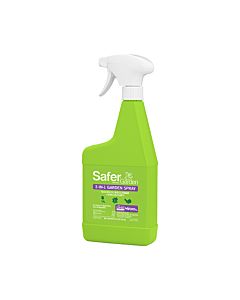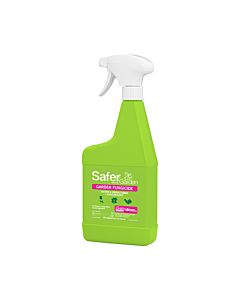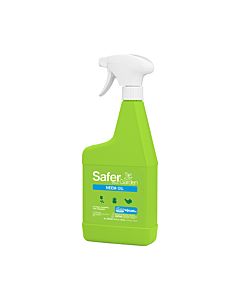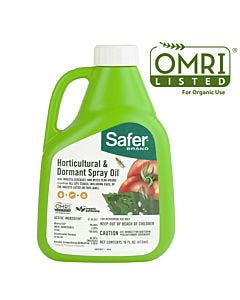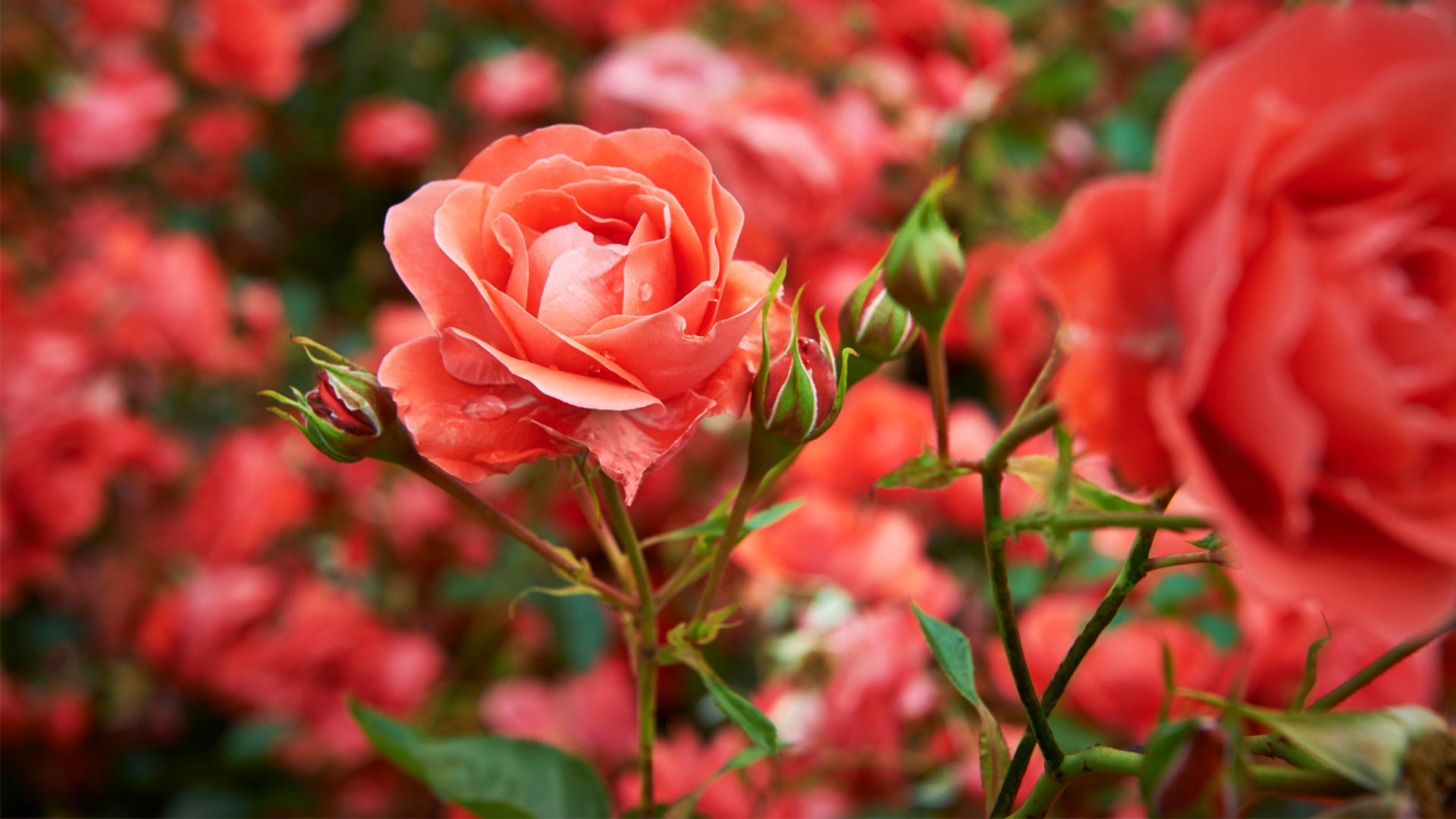
It starts gradually — a few yellowed leaves dropped to the ground, a few dark brown or black spots on the leaves you can easily attribute to just natural aging. Then suddenly, your rose bush looks terrible! Leaves are falling off at a rapid clip. Before tumbling to the ground, the leaves are dotted with black spots or splotches that fade into the leaf itself. As the days progress, nearly all the leaves yellow and fall from your prized roses, leaving a thorny skeleton behind. What happened? Was it an insect that attacked overnight or something else? If you have experienced this problem, find out how to banish black spots on your roses in 4 steps below.
PROTECT YOUR ROSES WITH SAFER®
Black Spot on Roses
If this scenario sounds familiar, welcome to the bane of the rose gardener’s existence: black spot on roses. Black spot (Marssonina rosae or Diplocarpans rosae) is a fungal disease considered to be the most serious rose disease in the world. The parasitical fungus spreads rapidly through direct contact among roses — usually at an infected grower’s site or in the home garden — or through wind-borne spores. Once black spot takes hold on a rose bush, it can quickly decimate the plant or weaken it to the extent that the plant dies.
What Causes Black Spots on Rose Leaves?
Before addressing horticultural practices to help prevent black spot disease, it’s important to understand what causes black spot on rose leaves.
Black spot is caused by a fungus, Marssonina rosae or Diplocarpans rosae. Scientists give this fungus two names to signify its normal state — Marsonnina — and its reproductive state — Diplocarpans. Most rose gardening sites simply refer to it as Diplocarpans rosae since it causes the most trouble when it’s reproducing and spreading throughout your garden, leaving behind noticeable yellow leaves with black spots on rose bushes.
Infected plants produce spores, and the spores are carried along by the wind until they land on the ground or on a plant. The spores must be moist for several hours in order to develop into full-fledged black spot, which is why the disease is more prevalent in areas with high humidity. Rainfall, mist, fog or even lawn sprinklers can provide sufficient moisture for black spot to thrive.
About two weeks after the spores infect a plant, the telltale black spots develop on the leaves. These black spots are what biologists call “fruiting structures.” The fruiting structures or spots produce spores, which continue to infect other areas of the same plant, new canes or other roses in the garden.
Black spot is a tenacious fungus — it thrives in warmth and moisture, but it tolerates a wide range of conditions including extreme heat and cold. Even a harsh winter won’t kill the spores lying dormant in your garden. To get rid of black spot disease on roses, you’ll need to try one or more of the four steps listed later in this article.
Some gardeners with severe infections may need all four steps to stop black spot in its tracks. This may seem extreme, but like many fungal diseases, black spot is tough to eradicate completely from the garden.
Symptoms of Black Spot Infection
At first, roses show no signs of infection. After the spores alight on a rose bush, it takes about two weeks for them to germinate and develop into mature fungus that can reproduce. Signs of black spot infection start small but rapidly increase, especially if the weather is particularly hot and humid.
Symptoms of black spot infection include:
- The telltale black spots or dots on the rose bush’s green leaves. These spots may start as a dark, chocolate brown and turn darker over time. They can be anywhere on the upper surface of the leaf. The edges are irregular, almost feathery, and extend out from the darker center.
- As the spots grow larger, the leaves turn yellow. The yellow leaves with black dots on roses form clusters of infected leaves. Soon, the whole plant looks sick. Eventually, leaves fall off the plant as their ability to make food (photosynthesis) is compromised by the infection.
- Both old and new canes can also be infected with black spot. Black spot on canes looks like a purple dot or blotch. If the cane dies, the pathogen remains in the cane, so new canes are immediately infected. Black spot can live inside a rose’s canes over the winter, too.
Why Is Black Spot Bad for Roses?
Black spot looks ugly, of course. Yellowed leaves on roses aren’t attractive, and when they fall off, they leave a bare, skeletal plant. More importantly, black spot weakens the entire plant so that it may eventually die.
Plants produce energy within special cells of their leaves called chloroplasts. These cells are like little food factories, using the sun’s rays to transform water and carbon dioxide into energy for growth, maintenance and reproduction. This process is called photosynthesis.
Because black spot defoliates roses, there are fewer leaves to produce energy for the plant. The plant cannot produce enough new leaves fast enough to make up for the shortfall. As new leaves emerge, they’re also infected, and soon the plant doesn’t have any way left to make its energy supply. Although some plants can survive a year of this, two or more years in a row weakens them to the point at which they die, or a harsh winter kills an already weakened plant. That’s why black spot is such a dreadful disease.
Some tough garden roses can, in fact, survive a black spot infection. Roses are an ancient plant. Fossilized specimens indicate they have been around for 35 million years. Individual specimens and some rose species do indeed have a natural resistance to black spot, but many hybrids, particularly hybrid tea roses, are extremely susceptible to black spot disease.
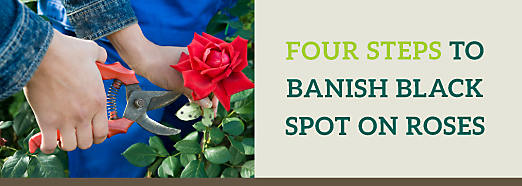
Banish Black Spot From Your Garden in Four Steps
Armed with a good description of black spot disease, you’ve determined the problem in your rose garden is most likely caused by this pest. Now it’s time to take action.
There are four steps you can take to combat black spot disease on roses:
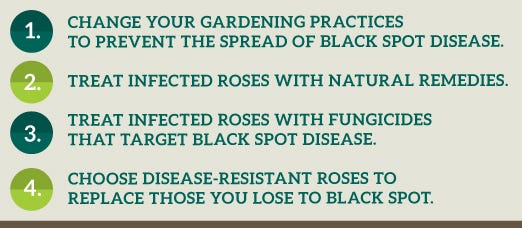
Step 1: Change Your Gardening Habits to Discourage Black Spot
Several gardening habits provide the ideal conditions necessary for the black spot spores to develop into full-blown disease. Here are five easy ways to help prevent black spot on roses.

Clean up your garden in the fall. Snip dead branches on perennials and shrubs and prune your roses. Don't compost these garden scraps. Instead, bag them and set them out for the trash, hence, if any black spot spores are on the canes, they’ll go to the landfill and not back into your compost pile where they may eventually infect yours or someone else’s roses.

Water at the base. Many automated watering methods, like sprinklers, tend to wet the leaves without delivering water beyond the drip line - boundary created by the foliage extending over the plant’s central stem. It’s within that drip line that the plant’s roots can take up water, and that’s where to direct your spray of water to be the most effective. Water the ground near the roots instead of soaking the bush with a spray from above.

Water in the morning. Evening watering schedules promote mold and fungus, including black spot. That’s because moisture and darkness make ideal conditions for these microorganisms to grow on plants. Morning watering gives the sun’s rays a chance to dry splashes of water on the leaves. Switch your watering schedule to the morning instead evening.

Clean and sterilize your tools. It’s a good idea to clean your pruners every time you use them. Keep a bottle of rubbing alcohol near your pruners and a clean rag — just wipe the blades with alcohol before putting them away. Dip or rub the blades in alcohol before using them on another plant, too. When you prune your roses, you create an open wound through which infection can enter the canes. Alcohol kills bacteria, mold and fungi.

Plant roses in full sun. Roses don’t do particularly well in shade. Partial shade, especially morning shade, keeps dew on the leaves just long enough to provide the conditions that black spot loves. Grow roses in full sunlight only.
Changing your gardening practices may not entirely prevent black spot, and they do not treat black spot if it’s already rampaging through your garden. What if you’re doing everything right, yet your roses still have black spot? It’s time to move on to step two in our list of steps to tackle black spot: Try natural remedies.
Step 2: Know the Remedies
Botanists have long searched for an effective, natural remedy for black spot on roses. Milk, a popular folk remedy, has been deemed ineffective by researchers at Washington State University. Although milk can be useful to help various foliar sprays stick to leaves, it may actually cause other diseases that can harm your roses.
So which natural cures do work for black spots on roses? A paper published in the Journal of Medicinally Active Plants lists the essential oils of English thyme and “Scotch” spearmint, two common plants, as potentially effective in the treatment of black spot disease.
The essential oils of these two garden herbs were tested against a control of fungicide and a second of water, and the results indicate that English thyme and “Scotch” spearmint both provided antifungal properties that lessened the severity of black spot lesions. Other herbal essential oil extracts were also tested, including that of sweet basil and holy basil, two other plants with alleged antifungal properties. Neither species of basil produced notable results.
Safer® Brand Neem oil, produced by the Asian Neem tree, offers some relief of black spot. Neem has notable antifungal properties that seem to work well on roses. Neem oil is also useful against powdery mildew, which is another fungus roses tend to get.
Step 3: Commercial Black Spot Sprays
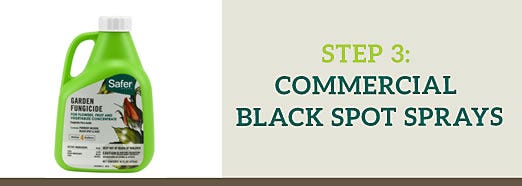
By far the most popular method of treating black spot on roses is through the use of conventional sprays. Sulfur compounds are effective at treating black spot. Safer® Brand Garden Fungicide uses sulfur as the active ingredient and is available in a convenient spray bottle or concentrate that can be mixed according to package directions for a foliar spray.
When using commercial fungicides in your garden, be sure to use only the recommended amount according to the label directions. More may not necessarily be better. Be sure to wash your hands and clothing after application, and dispose of the container according to the label on the package.
Step 4: Choose Roses Resistant to Black Spot
Rose growers should keep their eyes open for plants that aren’t susceptible to black spot. Disease-resistant roses should be grafted into hardy root stock to produce new plants with strong growth and resistance to common diseases. They may also breed new varieties of roses by crossing two kinds that are naturally disease resistant.
Thanks to the test of time and long-standing exposure to black spot, older rose varieties tend to have natural disease resistance. While many of these older roses have a different flower shape and petal configuration than what you may imagine when you hear the word “rose”, they often have a stronger fragrance, and they tend to be vigorous, healthy plants. It’s worth a try if you love roses but have trouble growing them due to black spot disease.
Keep in mind that roses may be resistant in one location, but not when planted in another. That’s because there are numerous strains of the black spot fungus. For example, a rose may be resistant in Oregon to one strain but susceptible to the strain living in Pennsylvania. Always try to purchase plants grown locally for your best chance at roses resistant to black spot.
Roses naturally resistant to black spot disease include:
- The Carpet Rose®: Flower Carpet roses are easy to care for and low-water tolerant. They have won numerous awards for their disease resistance, including Germany’s strict ADR awards where no chemicals are allowed to be used in the trials.
- Drift Roses: These ground cover roses only grow a little over a foot high and don’t require pruning. The Coral Drift and Sweet Drift varieties are fragrant.
- Floribunda Roses: Floribunda roses are a shrubby type of rose bush that produces copious sprays of small, rose-shaped flowers. Most shrub roses or Floribunda roses are hardy and disease resistant. Some are also resistant to rust and other fungal diseases in addition to being resistant to black spot.
- Meilland Hybrids: Originally grown in the south of France, Meilland hybrids are now available worldwide and are cultivated for disease resistance.
- Knock Out Roses®: These are a new rose hybrid produced by Star Roses and Plants. Available at nursery and garden centers nationwide, they are said to offer better disease resistance than similar plants.
Among the hybrid tea roses, several older varieties offer black spot resistance. These include Mr. Lincoln — a classic red tea rose — Tropicana — an orange variety — and Miss All American Beauty — a pink rose.
You can find black spot-resistant rose varieties from among all types of roses including climbing roses, miniature roses and more. With over 50 strains of black spot fungi identified, not all roses are resistant to each strain. Strains are found locally, so roses known to be black spot-resistant in local gardens are likely the best ones to plant in your garden for disease resistance.
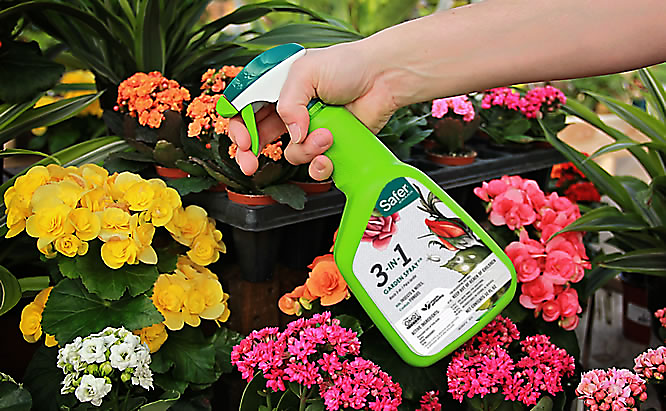
Black Spot Blues? Don’t Despair
Many roses naturally survive an outbreak of black spot. The earlier you begin treating your roses for black spot the better chances it has at recovering.
One rose, the Hildesheim climbing rose, has been verified by scientists to be over 1,000 years old. If a rose can survive 1,000 years of exposure to black spot and other diseases, maybe your rose can survive, too.

